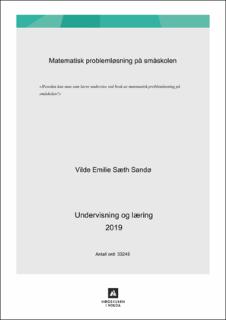| dc.contributor.advisor | Berget, Ingeborg Katrin | |
| dc.contributor.advisor | Smestad, Bjørn | |
| dc.contributor.author | Sandø, Vilde Emilie Sæth | |
| dc.coverage.spatial | Norway | nb_NO |
| dc.date.accessioned | 2020-03-03T14:06:24Z | |
| dc.date.available | 2020-03-03T14:06:24Z | |
| dc.date.issued | 2019 | |
| dc.identifier.uri | http://hdl.handle.net/11250/2645004 | |
| dc.description.abstract | Til tross for at det allerede finnes mye teori som peker på gevinstene ved å arbeide med matematisk problemløsning, samt at problemløsning stadig får en tydeligere plass i læreplanen, er dette en undervisningsmåte som krever mye av læreren og som ofte prioriteres ned. I denne studien har jeg forsket på hva problemløsningsarbeid i matematikken på småskolen krever av læreren. Dette har jeg gjort med følgende problemstilling: «Hvordan kan man som lærer undervise ved bruk av matematisk problemløsning på småskolen?»
For å svare på denne problemstillingen har jeg konstruert seks forskningsspørsmål som jeg har fokusert på gjennom arbeidet. Disse forskningsspørsmålene har jeg funnet med utgangspunkt iblant annet Mason, Burton og Staceys (2010) tredelte modell av problemløsningsprosessen. Hovedfokuset i teorigrunnlaget er basert på lærerens arbeid, men også på ulike faser i problemløsningsprosessen og hvorfor problemløsning er viktig.
Metoden jeg har brukt til å samle inn empiri, er et kvalitativ tverrsnittdesign. Datamaterialet er hovedsakelig bygd på fem semistrukturerte intervjuer av fem lærere på 1.-4. trinn, men jeg har også observert seks dobbelttimer i undervisningen deres, da jeg hos den ene læreren fikk observere undervisning på to forskjellige trinn. Dette har bidratt til å gi et dypere innblikk i hvordan man kan arbeide med matematisk problemløsning på småskolen.
Analyse og drøftingskapittelet er inndelt med fokus på å besvare forskningsspørsmålene jeg satt for oppgaven. I resultatkapittelet svarer jeg på problemstillingen gjennom hovedfunnene i drøftingen. | |
| dc.description.abstract | Summary
Even though there already exists a lot of theory showing the advantages of mathematical problem solving, and that problem solving is becoming more emphasized in the curriculum, this particular teaching method requires a lot of work from the instructor and is often deprioritized. In this study I look at what mathematical problem solving at the elementary school level requires from the instructor. Thus, my thesis/topicquestion is as follows: “How can instructors teach using mathematical problem solving at the elementary school level?”
In order to answer this thesis, I have constructed six research questions to focus on throughout my study. These questions were constructed based on the three-part model of the problem solving process laid forth by Mason, Burton, and Stacey (2010). The main focus in this theory is based on the instructor’s work, but it also focuses on different phases in the problem solving process and the question of why problem solving is important.
In order to collect empirical data I used the method of qualitative cross-sectional design. Primarily, my data comes from the five semi-structured interviews I did with five elementary school (1stgrade through 4thgrade) instructors. However, I also observed six double period classes from the instructors where one of the instructors let me observe their teaching in two different grades. This allowed me to gain a more meaningful insight in how to work with mathematical problem solving in the 1st, 2nd, 3rd, and 4th grades.
The section on analysis and discussion is divided in a way to keep the research questions in focus. The results section answers the topic question through the findings in the discussion. | en |
| dc.publisher | Høgskulen i Volda | nb_NO |
| dc.title | Matematisk problemløsing på småskolen. "Hvordan kan man som lærer undervise ved bruk av matematisk problemløsing på småskolen?" | nb_NO |
| dc.title.alternative | Hvordan kan man som lærer undervise ved bruk av matematisk problemløsing på småskolen? | nb_NO |
| dc.type | Master thesis | nb_NO |
| dc.source.pagenumber | 93 | nb_NO |
